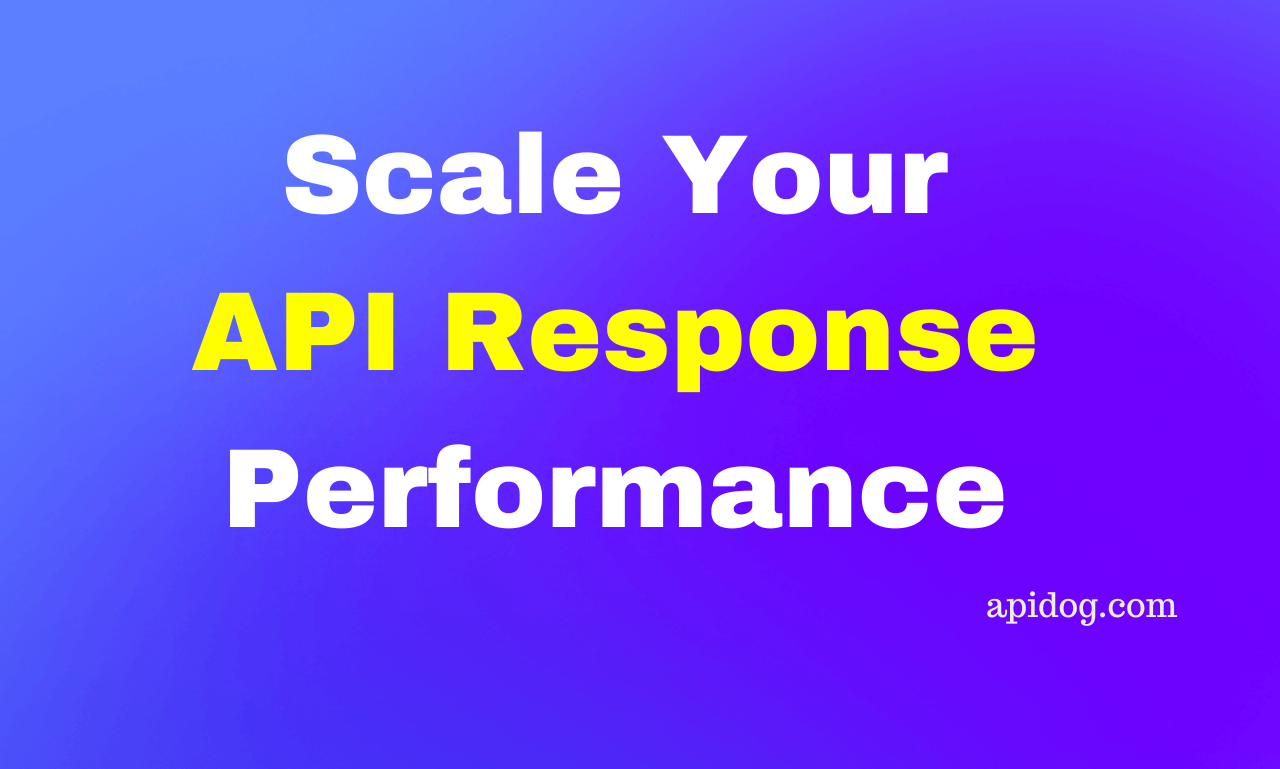Introduction:
API response time is a crucial aspect of modern software development, directly impacting user experience, system efficiency, and ultimately, business success. In today's fast-paced digital landscape, users expect near-instantaneous responses from applications and services. Slow APIs can lead to frustrated users, decreased productivity, and lost revenue opportunities. As a result, optimizing API performance has become a top priority for organizations across various industries.
So, what are we going to do in this article? This article will explore practical strategies and techniques for increasing API speed to meet industry standards. From identifying performance bottlenecks to implementing caching mechanisms and leveraging asynchronous programming, we'll provide actionable insights for CTOs and technical leaders to enhance the performance of their APIs and deliver exceptional user experiences.
Prerequisites:
To effectively optimize API performance, it's essential to have a solid understanding of APIs and their role in software development. Familiarity with databases and networking concepts is also beneficial. Additionally, access to monitoring tools and performance profiling techniques will facilitate identifying performance bottlenecks and measuring optimization efforts. While advanced knowledge in these areas is advantageous, if you have intermediate-level experience or willingness to learn, you should be able to follow along and implement the strategies outlined in this article.
Before we continue with this article though, it's important to mention that we'll not write any code in this article. The tips and valid information that you'll learn from this article can be used in any codebase.
What is a good/Bad or Fast/Slow API Response?:
I. Introduction
In the dynamic landscape of modern software development, the speed and efficiency of APIs play a pivotal role in determining the success of applications and services. However, what defines a "good" or "bad" response time can vary depending on factors such as industry standards, user expectations, and the nature of the application. Let's delve into what constitutes good or bad response times in the context of API performance optimization.
Understanding Response Time: Good vs. Bad
In general, a "good" response time for an API is one that meets or exceeds user expectations, enabling seamless interaction with the application or service. Conversely, a "bad" response time is one that falls short of these expectations, resulting in sluggish performance, user frustration, and potential business impact. But how do we quantify what constitutes a good or bad response time?
Industry Standards and User Expectations
Industry standards and user expectations serve as benchmarks for defining good or bad response times. For example, in industries where real-time interactions are critical, such as finance or gaming, response times measured in milliseconds such as 0.1 - 0.5 milliseconds are often considered ideal. On the other hand, in less time-sensitive applications, such as content delivery or administrative tasks, response times measured in seconds such as 5-15 seconds may be acceptable.
Impact on User Experience
Ultimately, the perception of response time is subjective and influenced by factors such as user context, task complexity, and previous experiences. A response time that is considered acceptable for one user or application may be deemed unacceptable for another. Therefore, understanding the impact of response time on user experience is paramount for optimizing API performance.
That's just a quick overview and understanding of what a Good/Bad API response is all about. Here's a (short) quick guide to getting started with an industry-standard guide to API response time.
With that aside, let's now talk about "How to Optimize API response time".
Identifying Performance Bottlenecks

Achieving optimal performance requires more than just wishful thinking; it demands a meticulous examination of potential bottlenecks that can impede API responsiveness. In this section, we delve into the process of identifying performance bottlenecks and discuss the tools and techniques essential for pinpointing areas ripe for optimization.
A. Utilizing Monitoring Tools and Performance Profiling Techniques
Monitoring tools and performance profiling techniques serve as invaluable assets in identifying performance bottlenecks. These tools provide real-time insights into the behavior of APIs, enabling developers to identify areas of inefficiency and pinpoint potential bottlenecks. Among the arsenal of monitoring tools available, specialized platforms such as New Relic, Datadog, and Prometheus offer comprehensive performance metrics, including response times, error rates, and resource utilization. By leveraging these tools, developers can gain a holistic view of API performance and uncover underlying issues that may hinder optimal responsiveness.
Performance profiling techniques complement monitoring tools by offering granular insights into the inner workings of APIs. Profilers such as the popular Chrome DevTools, Java Flight Recorder, and Python's cProfile allow developers to analyze code execution, memory usage, and CPU utilization. By profiling API endpoints under various scenarios, developers can identify performance hotspots, inefficient algorithms, and resource-intensive operations. With this knowledge, developers can prioritize optimization efforts and address performance bottlenecks with surgical precision.
B. Database Queries, Inefficient Code, Network Latency, Third-Party Integrations
Performance bottlenecks can manifest in various forms, each posing unique challenges to API responsiveness. Among the most common culprits are:
Database Queries: According to a discussion posted on Serverfault.com, slow or poorly optimized database queries can significantly impact API performance. Common issues include missing indexes, inefficient joins, and excessive data retrieval. By analyzing database query execution plans and optimizing query structures, developers can mitigate the performance impact of database interactions and improve overall API responsiveness.
Inefficient Code: Inefficient algorithms, resource-intensive loops, and redundant operations can degrade API performance. Code profiling tools can help identify areas of code that consume excessive CPU cycles or memory, allowing developers to refactor code for improved efficiency. By optimizing data structures, eliminating unnecessary computations, and leveraging language-specific performance optimizations, developers can eliminate performance bottlenecks rooted in inefficient code.
Network Latency: Network latency, caused by factors such as geographic distance, network congestion, and server load, can contribute to sluggish API performance. Techniques such as connection pooling, HTTP/2 multiplexing, and content delivery networks (CDNs) can help mitigate the impact of network latency by reducing the number of round trips and optimizing data transfer protocols.
Third-Party Integrations: Integration with third-party services and APIs introduces dependencies that can impact API performance. Delays in third-party service responses, network timeouts, and rate limits can all contribute to degraded API responsiveness. Unfortunately, you can't fully control third integrations. However, to address these challenges, developers can implement caching mechanisms, asynchronous processing, and circuit breaker patterns to gracefully handle failures and minimize the impact of third-party integrations on API performance.
Implementing Caching Mechanisms
In the previous section, we talked about identifying Performance Bottlenecks. We saw how to use some tools to track and find the pinpoint of what can be causing our API responses to be slow. In this section, we will explore the importance of caching in improving API speed, the various types of caching mechanisms available, and strategies for implementing effective caching mechanisms.

A. Importance of Caching in Improving API Speed:
The Term/word "Cache" means storing or keeping something for future use. In software developments, caching plays a pivotal role in improving API speed by reducing the need for repetitive computations and data retrieval operations. By storing frequently accessed data in memory or a distributed cache, caching mechanisms eliminate the latency associated with fetching data from slower sources such as databases or external services.
This results in faster response times, improved scalability, and enhanced reliability of APIs. Additionally, caching helps mitigate the impact of sudden spikes in traffic by serving cached responses to subsequent requests, thereby relieving pressure on backend systems and ensuring consistent performance under varying loads.
B. Types of Caching Mechanisms:
Application-Level Caching: Application-level caching also known as memorization involves storing data within the application's memory for quick retrieval. This type of caching is well-suited for storing frequently accessed data that is relatively static and shared across multiple requests. Popular frameworks and libraries often provide built-in support for application-level caching, making it easy to implement and manage.
Database Query Caching: Database query caching involves caching the results of database queries to avoid redundant database access. By storing query results in memory or a dedicated cache, subsequent requests for the same data can be served directly from the cache, bypassing the need for costly database queries. This can significantly reduce database load and improve API responsiveness, especially for read-heavy workloads.
Content Caching with CDNs: Content caching with Content Delivery Networks (CDNs) involves caching static assets such as images, CSS files, and JavaScript libraries at edge locations distributed globally. CDNs cache content closer to end-users, reducing latency and improving the delivery speed of static resources. By offloading the delivery of static content to CDNs, APIs can focus on serving dynamic content and processing business logic, leading to faster response times and improved overall performance.
Cloudflare is the industry's leading CDN provider, making static assets caching much more effective.
C. Strategies for Implementing Effective Caching Mechanisms:
Identify Cacheable Data: Begin by identifying data that are suitable for caching, such as frequently accessed resources, static content, or computationally expensive computations. Not all data is suitable for caching, so it's essential to prioritize caching efforts based on the frequency of data access and its impact on API performance.
Set Cache Expiration Policies: Define cache expiration policies to ensure that cached data remains fresh and up-to-date. Consider factors such as data volatility, frequency of updates, and expiration time windows when configuring cache expiration policies. Implement techniques such as time-based expiration, invalidation on data updates, or cache warming to maintain cache consistency and prevent stale data from being served to users.
For example, you may want to store a user's access token or OTP code in a cache. Storing that credential in cache isn't a bad idea, but not setting an expiration date for those is a bad idea.
Monitor and Tune Caching Performance: Continuously monitor caching performance metrics such as hit ratio, eviction rate, and cache utilization to assess the effectiveness of caching mechanisms. Fine-tune caching configurations based on observed performance metrics and user behavior to optimize cache utilization and ensure maximum benefit from caching. Sentry is currently working on a feature that can help you track your cache, you can try that out!
Implement Cache Invalidation Strategies: Implement cache invalidation strategies to ensure that stale or outdated data is purged from the cache on time. Use techniques such as time-based expiration, event-driven invalidation, or manual cache clearing to invalidate cached data when it becomes obsolete or no longer relevant. By maintaining cache freshness and consistency, API reliability and performance can be improved, enhancing the overall user experience.
In conclusion, implementing caching mechanisms is a powerful strategy for improving API speed and responsiveness. By leveraging application-level caching, database query caching, and content caching with CDNs, developers can reduce latency, offload backend systems, and deliver faster, more reliable APIs.
Utilizing Asynchronous Programming
Asynchronous programming emerged as a powerful technique to enhance API responsiveness, tackle I/O-bound operations efficiently, and adhere to best practices for scalable and resilient API design. In this section, we delve into the benefits of asynchronous programming, explore its implementation for I/O-bound operations, and discuss best practices for leveraging asynchronous programming in API development.
A. Benefits of Asynchronous Programming for API Responsiveness
Asynchronous programming offers several compelling benefits for improving API responsiveness:
- Non-Blocking Operations: Asynchronous programming allows APIs to handle multiple requests concurrently without blocking the execution thread. This enables APIs to remain responsive and serve other requests while waiting for I/O-bound operations to complete.
- Improved Scalability: By freeing up execution threads to handle other tasks during I/O operations, asynchronous programming enhances the scalability of APIs, allowing them to handle a higher volume of concurrent requests without sacrificing performance.
- Reduced Resource Consumption: Asynchronous programming minimizes resource consumption by avoiding the need to allocate dedicated threads for each request. This results in efficient resource utilization and lower operational costs for API infrastructure.
B. Implementing Asynchronous Processing for I/O-Bound Operations
Implementing asynchronous processing for input/output (I/O) bound operations involves leveraging asynchronous programming constructs such as coroutines, event loops, and non-blocking I/O operations. By decoupling I/O operations from the main execution thread, APIs can handle multiple requests concurrently and maintain responsiveness. Common techniques for implementing asynchronous processing include:
- Using Async/Await: Modern programming languages and frameworks offer built-in support for asynchronous programming through constructs such as async/await (e.g., async/await in Python, async/await in C#, async/await in JavaScript). By marking I/O-bound operations with the async keyword and awaiting their completion asynchronously, APIs can achieve non-blocking behavior and improved responsiveness.
- Utilizing Event Loops: Event-driven architectures and event loops facilitate asynchronous processing by allowing APIs to register callbacks or event handlers for I/O events. Asynchronous libraries and frameworks built on top of event loops (e.g., asyncio in Python, Node.js in JavaScript) provide high-level abstractions for writing non-blocking code and handling asynchronous I/O operations efficiently.
C. Best Practices for Utilizing Asynchronous Programming in API Development
To harness the full potential of asynchronous programming in API development, it's essential to adhere to best practices:
- Identify I/O-Bound Operations: Identify I/O-bound operations that can benefit from asynchronous processing, such as database queries, network requests, and file I/O operations. Prioritize asynchronous optimization efforts based on the impact of these operations on API responsiveness.
- Handle Errors Gracefully: Asynchronous programming introduces complexities related to error handling and exception propagation. Implement robust error-handling mechanisms to gracefully handle errors and failures in asynchronous code, ensuring API reliability and resilience.
- Optimize Resource Utilization: Monitor and optimize resource utilization to prevent bottlenecks and maximize the efficiency of asynchronous APIs. Fine-tune concurrency settings, thread pools, and resource allocation to achieve optimal performance under varying workloads.
- Test Thoroughly: Thoroughly test asynchronous APIs under different scenarios and load conditions to ensure reliability, scalability, and responsiveness. Use stress testing, performance profiling, and real-world simulation to identify potential bottlenecks and areas for optimization.
Conducting Load Testing
In this section, we explore the importance of load testing, delve into the use of load testing tools such as Nginx to simulate realistic traffic, and discuss strategies for analyzing load testing results to optimize API performance.
A. Importance of Load Testing in Identifying Performance Bottlenecks
Load testing plays a pivotal role in identifying performance bottlenecks and uncovering potential vulnerabilities in API systems. By subjecting APIs to simulated loads and stress conditions, load testing enables developers to:
- Detect Performance Degradation: Load testing helps detect performance degradation and bottlenecks under varying levels of concurrent user activity, allowing developers to pinpoint areas of inefficiency and address them proactively.
- Validate Scalability: Load testing validates the scalability of API systems by assessing their ability to handle increasing loads without compromising performance or reliability. By simulating anticipated user traffic, developers can ensure that API systems scale gracefully under peak demand.
- Mitigate Risks: Load testing identifies potential risks and failure points in API systems, enabling developers to implement proactive measures to mitigate downtime, data loss, and performance issues before they impact users.
B. Using Load Testing Tools to Simulate Real-World Traffic
Load testing tools provide developers with the means to simulate real-world traffic and assess the performance of API systems under different scenarios. Nginx, a popular web server and reverse proxy server, offers powerful capabilities for load testing through its load testing module. In this article, I'll focus on Nginx as it's the most popular and wildly used server that can be hosted and used by almost everyone.
With Nginx, developers can:
- Configure Load Testing Scenarios: Nginx allows developers to define custom load testing scenarios, specifying parameters such as request rates, concurrency levels, and request distribution patterns. By tailoring load testing scenarios to mimic real-world traffic patterns, developers can accurately assess API performance under realistic conditions.
- Generate Realistic Workloads: Nginx's load testing module generates realistic workloads by simulating concurrent user activity, HTTP requests, and network traffic. By generating load from multiple client machines or distributed locations, developers can evaluate API performance across diverse geographical regions and network conditions.
Testing with Apidog:
Apidog is an integrated collaboration platform that combines API documentation, debugging, mock testing, and testing. It can help you design, develop, and test APIs quickly, improve development efficiency, and supports HTTP, SOAP, WebSocket, and other protocols.

By analyzing performance metrics in real time during load testing, developers can identify performance bottlenecks and make data-driven decisions to optimize API performance.
With Apidog, you can do just that!
Conclusion
In today's digital landscape, where speed and responsiveness reign supreme, optimizing API performance is not just a goal—it's a necessity. Throughout this comprehensive guide, we've explored the intricacies of enhancing API speed, tackling performance bottlenecks, and setting the bar for optimal performance. From identifying bottlenecks and implementing caching mechanisms to leveraging asynchronous programming and conducting load testing, every aspect of API optimization plays a crucial role in delivering exceptional user experiences and driving business success.
However, optimization is not a one-time endeavor—it's an ongoing process of iteration, refinement, and continuous improvement. As we strive to optimize API performance, we must embrace a culture of continuous monitoring, testing, and iteration. By monitoring performance metrics, analyzing load testing results, and gathering user feedback, we gain valuable insights into the effectiveness of our optimization efforts and identify areas for further refinement.
In summary, API response time is an asset in our company or project that we can't afford to sideline. I hope that this guide has provided some tips and information that can and will help you increase your API response time. Thanks for reading, if you have any question, don't forget to reach out - we'll be more than happy to help!



